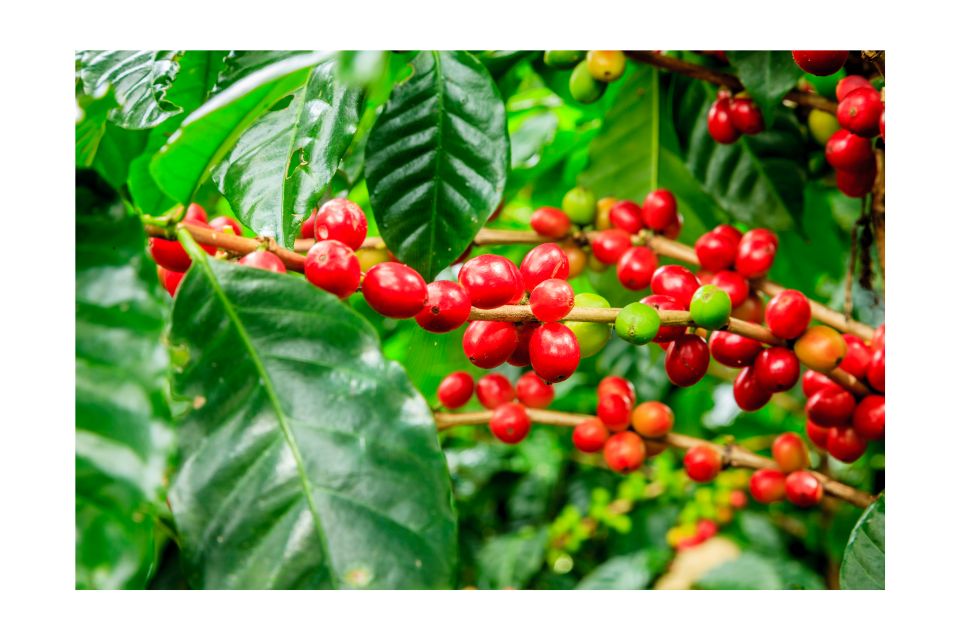Ever wondered where your favorite morning beverage originates from? I have, and that curiosity led me to investigate the fascinating journey of coffee beans, starting right from their humble roots.
This blog post uncovers the growth of coffee beans – everything from how they’re grown to how they end up in your cup every morning. Trust me, understanding this process will deepen your appreciation for each sip.
Ready for an adventure?.
Key Takeaways
- Coffee beans originate from the seeds of cherries that grow on coffee trees and shrubs in African forests.
- They are cultivated in regions such as Africa, Southeast Asia, and South America, with specific requirements like tropical climates, well-drained soil, and high altitudes.
- The equator plays a crucial role in coffee bean production due to ideal conditions for growth along the “bean belt,” which includes countries like Brazil, Colombia, Ethiopia, and Indonesia.
- The journey of coffee beans involves careful harvesting of ripe cherries by hand, processing steps such as sorting, pulping, fermentation
What Does a Coffee Plant Look Like?

Coffee Beans and Their Origins
Coffee beans have their origins in the seeds of fruits grown on trees and shrubs found in African forests.
The coffee plant and its cultivation
Diving straight into our topic, let’s talk about the coffee plant and its cultivation. Born in the lush forests of Ethiopia, the heartland of all coffee trees is this unique African nation – specifically a province known as Kaffa.
These humble beginnings have led to an extensive journey spanning centuries and continents to bring you your favorite brew.
The whole process begins with tiny seeds, which are actually our beloved beans! Cultivated primarily on sprawling plantations and smaller farms across Africa, Southeast Asia, and South America, these seeds sprout into shrubs or small trees that bear enticing fruit known as cherries.
The reddish-purple wonders aren’t just attractive; nestled within them lie the precious treasures we covet – coffee beans.
These plants relish tropical climates near the equator where there’s ample rainfall but require a precise balance – not too hot or bitterly cold either. They also need well-drained soil and applaud high altitudes for quality production—upwards of 600 meters offers optimal conditions for these delicate lifeforms.
From seed to sapling it takes between four to five years for a coffee tree to mature fully but don’t be fooled by their petite size – they pack quite a punch when it comes to yield! One mature tree can produce up to 1kg of roasted coffee annually which amounts to roughly 120 cups depending on how strong you like your brew!
With such complex cultivation requirements yet generous outcomes, no wonder farmers globally work relentlessly nurturing these crops year-round ensuring we can enjoy our comforting cup of joe anytime we please.
The regions where coffee is grown
As a coffee lover, it’s fascinating to explore the regions where our beloved beans are grown. Coffee is cultivated in various parts of the world, with each region bringing its unique flavors to the mix.
Some of the top coffee-growing regions include Latin America, eastern Africa, Asia, and Arabia. These areas have ideal climates and altitudes for coffee production.
Latin America is renowned for producing high-quality Arabica beans. Countries like Brazil and Colombia dominate this region’s coffee scene. The rich volcanic soil in these areas imparts a distinct flavor profile to their coffees.
Eastern Africa boasts countries like Ethiopia, where coffee originated. Here, you’ll find both Arabica and Robusta beans that provide bright acidity and floral notes in your cup.
Asia also plays a significant role in coffee production. Indonesia is known for its full-bodied and earthy flavors that come from Sumatra or Java beans.
Lastly, Arabian countries like Yemen produce unique varieties with spicy undertones due to their traditional dry processing methods.
The importance of the equator and the Bean belt
The equator plays a crucial role in the production of coffee beans. Coffee plants thrive in tropical climates, and regions along the equator provide the ideal conditions for their growth. This line encircling our planet ensures a consistent amount of sunlight year-round, which is necessary for coffee trees to flourish.
The combination of warm temperatures, ample rainfall, and high altitudes found near the equator creates what is known as the “bean belt.” This expansive region includes countries such as Brazil, Colombia, Ethiopia, and Indonesia – all major players in the global coffee industry.
Thanks to the equatorial position of these areas, they offer optimal environments for cultivating delicious coffee beans that are cherished by baristas and enthusiasts worldwide.
In addition to temperature and rainfall patterns influenced by proximity to the equator, altitude also contributes significantly to quality bean production within this “bean belt.” High-altitude regions typically experience cooler temperatures with more pronounced seasonal variations throughout the year.
These climate characteristics slow down cherry maturation on coffee plants but result in denser beans packed with flavors and aromas that invigorate our senses when brewed into a cup of joe.
How Long Does It Take for a Coffee Plant to Grow?
The growth process of coffee, one of the world’s most beloved beverages, is fascinating. Coffee plants, belonging to different species, such as arabica and robusta, produce the fruit known as coffee cherries. From the moment the coffee cherries grow on the plant to the time the beans are harvested, it takes several months. The cherries start as small green fruits and gradually develop into dark green cherries.
The best coffee cherries are left on the plant until they ripen to ensure quality coffee. Coffee farmers carefully pick the ripe cherries by hand, ensuring that only the fully matured ones are selected. Once harvested, the coffee beans are processed, which involves removing the outer layers of the cherries to reveal the beans. Depending on the desired flavor profile, the beans may undergo further steps such as fermentation, washing, or drying.
After processing, the coffee beans are roasted by coffee roasters to bring out the desired flavors and aromas. This crucial step in the coffee journey transforms the green beans into the aromatic brown beans we use to make coffee. Whether you prefer instant coffee or specialty coffee, the process from the coffee plant to your favorite cup of joe is a labor of love.
Coffee connoisseurs appreciate the efforts of coffee growers who dedicate their time and expertise to producing high-quality coffee beans. With over 400 million cups of coffee consumed worldwide each day, the demand for this beloved beverage is undeniable. Coffee comes in different types, and its rich history spans continents. Africa is known for its exquisite arabica coffee beans, while robusta coffee is grown in various regions around the globe.
From the anatomy of a coffee plant to the extensive efforts of coffee farmers, every step in the coffee production chain contributes to the enjoyment of a great cup of coffee. Whether you crave a strong and bold brew or savor the delicate flavors of specialty coffee, the love for coffee remains a universal passion among many coffee lovers.
As coffee plants grow,
they require specific conditions to thrive. They need a suitable climate, rich soil, and adequate rainfall. Coffee plants are often cultivated in regions known as the “coffee belt,” which encompasses countries near the equator. The majority of coffee production is dominated by countries in Africa, followed by regions in Central and South America, and Asia. Coffee growers meticulously tend to their plants, ensuring they receive proper care and attention.
It takes time for the coffee cherries to develop and mature, typically ranging from 7 to 9 months. Once the cherries are ripe, they are carefully harvested, either by hand or using mechanized methods. The harvested coffee cherries undergo processing to extract the beans.
This process can involve either the dry method, where the cherries are dried and the beans are removed, or the wet method, which includes fermenting and washing the cherries before extracting the beans. The processed coffee beans are then ready for roasting, which is a crucial step in bringing out the unique flavors and aromas. Coffee roasters expertly roast the beans to achieve different roast profiles, ranging from light to dark.
Finally, the roasted coffee beans are ground and brewed to make coffee. From the moment the coffee plant is cultivated to the time the brewed coffee reaches your cup, the entire journey can take anywhere from several months to over a year. It’s a testament to the dedication and passion of coffee farmers and the meticulous processes involved in producing high-quality coffee beans.
So the next time you sip your favorite cup of coffee, remember the journey it took from the coffee plant to your mug and appreciate the love and craftsmanship that goes into every sip.
The Journey of Coffee Beans
After being carefully harvested, the coffee cherries are processed to extract the beans before they undergo the crucial stage of roasting for that perfect cup of coffee.
The harvesting process
When coffee cherries are ripe and ready to be harvested, they are carefully picked by hand. This ensures that only the fully mature cherries are selected for processing. Once the cherries have been collected, they go through a series of steps to extract the beans:
- Sorting: The harvested cherries are sorted to remove any damaged or unripe ones. Only the best quality cherries make it to the next step.
- Pulping: The outer layer of each cherry, known as the pulp, is removed. This can be done using different methods such as wet or dry processing.
- Fermentation: After pulping, the beans are left to ferment in water for a certain period of time. This helps to remove any remaining fruit residue and enhances flavor development.
- Washing: Once fermentation is complete, the beans are thoroughly washed to remove any remaining residue from the fermentation process.
- Drying: The washed beans are spread out in thin layers on large drying beds or patios to dry in the sun. This process can take several days, and it allows the moisture content of the beans to reduce significantly.
- Hulling: Once dried, the outer layer, called parchment, is removed from each bean through a process called hulling. This reveals the green coffee bean inside.
- Sorting and grading: The hulled coffee beans go through another round of sorting and grading based on size, color, and other quality factors.
- Packaging and storage: Finally, the sorted coffee beans are packaged in bags or containers for transportation and storage until they reach their final destination.
Processing the cherries to extract the beans
After the coffee cherries have been carefully harvested, they undergo several important steps to extract the precious coffee beans inside. Let’s explore the fascinating process together:
- Picking: Skilled workers selectively handpick only the ripest cherries from the coffee trees. This ensures that only the highest quality beans are used in production.
- Sorting: The harvested cherries are sorted to separate any underripe or overripe cherries from the perfectly ripe ones. This meticulous sorting ensures consistency in flavor and quality.
- Pulping: Once sorted, the cherries are pulped to remove their outer skins and expose the beans inside. Traditional methods involve using a machine that squeezes out the beans while separating them from the pulp.
- Fermentation: The pulped beans are then placed in water tanks for fermentation, which helps break down any remaining fruit residue on the beans. This step contributes to developing desirable flavors during roasting.
- Washing: Following fermentation, thorough washing of the beans takes place to remove any remaining impurities or unwanted flavors acquired during fermentation.
- Drying: The washed beans are spread out on large surfaces or raised beds to dry naturally under sunlight or by using mechanical dryers specifically designed for coffee beans. Drying is a crucial step that determines moisture content and flavor development.
- Milling and Hulling: After drying, an outer protective layer called parchment is removed from the dried beans through milling and hulling processes. This reveals clean green coffee beans ready for roasting.
- Grading and Sorting: Beans go through rigorous grading and sorting based on size, shape, color, density, and defects before being packaged for export or further processing.
- Roasting (Let’s take a moment here – who doesn’t love that fragrant aroma?): The green coffee beans are carefully roasted at specific temperatures to unlock their unique flavors and aromas. Roasting transforms them into familiar brown beans we cherish.
- Final Inspection: Before the coffee beans are packaged and sent to market, they undergo a comprehensive quality check for consistency, flavor profiles, and overall appearance. This ensures every batch meets the highest standards.
Roasting the beans to perfection
Roasting the coffee beans is a crucial step in creating that perfect cup of Joe. It’s where the magic happens, turning raw green beans into aromatic and flavorful gems. Here’s a breakdown of what goes into roasting coffee beans to perfection:
- The art of timing: Roasting coffee beans involves carefully controlling the temperature and time. Too short, and the flavors won’t fully develop; too long, and they’ll get burnt. It’s all about finding that sweet spot for each batch.
- Unlocking flavors: During roasting, heat causes chemical reactions within the coffee beans, resulting in the release of oils and aroma compounds. This process brings out the unique characteristics of different coffee varieties, from fruity notes to chocolatey undertones.
- The color transformation: Green coffee beans start off pale in color, but as they roast, they gradually darken and take on various shades depending on the desired roast level – be it light, medium, or dark. Each roast level offers a distinct flavor profile.
- Listen for that crack: As the roasting progresses, you might hear a cracking sound coming from inside the roaster. This crack marks an important milestone in the process – it signals that the moisture inside the bean is being released.
- Cool-down time: Once roasted to perfection, it’s essential to cool down the beans quickly to prevent further cooking and preserve their flavor profile. This can be done using fans or by transferring them to cooling trays.
- The importance of freshness: While freshly roasted coffee is at its peak flavor immediately after cooling down, it’s also worth noting that coffee needs some resting time before brewing. This allows gases trapped during roasting to escape, leading to a smoother cup.
- Experimentation is key: Roasting allows for endless experimentation with flavors and profiles by adjusting factors like temperature and time throughout the process. So whether you prefer your brew light and bright or dark and bold, there’s room to play around and find your perfect roast.
Common Types of Coffee Beans
There are three common types of coffee beans: Arabica, Robusta, and decaf. Coffee enthusiasts will find it fascinating to learn about the characteristics and attributes that make each type unique.
Read on to explore the world of coffee beans in more detail!
Arabica coffee beans and their characteristics
Arabica coffee beans are known for their delicate flavors and smooth, well-balanced taste. These beans have a slightly sweet and fruity aroma that can vary depending on the region where they are grown.
With their lower acidity levels compared to Robusta beans, Arabica coffee is less likely to cause stomach discomfort or heartburn. The high-quality Arabica beans also tend to have a higher caffeine content than Robusta beans, making them perfect for those seeking an energizing cup of joe in the morning.
Popular Arabica varieties include Bourbon, Typica, and Caturra. Whether you prefer it black or with a splash of milk, Arabica coffee beans deliver a delightful and satisfying experience every time you brew them.
Robusta coffee beans and their attributes
One of the most popular types of coffee beans in the world is Robusta. Known for its bold and strong flavor, Robusta beans are loved by many coffee enthusiasts. These beans have a higher caffeine content compared to Arabica beans, making them an excellent choice for those who need that extra kick to start their day.
They also have a thicker body and a richer aroma, which adds depth to your cup of joe.
The regions where Robusta coffee beans are grown include Latin America, eastern Africa, Asia, and Arabia. These areas provide the perfect climate and soil conditions for the robusta shrubs to thrive.
The resulting beans are rounder and more convex than their Arabica counterparts.
If you prefer a stronger taste with hints of chocolate or earthy notes in your morning brew, then Robusta coffee beans may be just what you’re looking for. Their bolder flavor profile makes them ideal for espresso shots and blends that require a robust taste foundation.
Decaf coffee beans and how they are produced
Decaf coffee beans have become increasingly popular among coffee lovers who want to enjoy the rich flavors and aroma of coffee without the stimulating effects of caffeine. To produce decaf beans, green coffee beans undergo a process called decaffeination.
There are different methods used to remove the caffeine from the beans, including solvent-based processes, water processes, and carbon dioxide processes.
One common method is known as the Swiss Water Process. In this method, green coffee beans are soaked in hot water to extract their flavor compounds and caffeine. The resulting mixture is then passed through activated charcoal filters that selectively remove only the caffeine molecules while leaving behind other desirable compounds responsible for taste.
Afterward, these “flavor-charged” water-saturated green coffee beans are discarded while retaining their unique flavors.
Another technique involves using solvents like methylene chloride or ethyl acetate to dissolve caffeine from the green coffee beans selectively. Once the solvent has bonded with the caffeine molecules, it is removed from the solution using steam or another filtering process.
The remaining flavorful liquid is reintroduced to new batches of green coffees that can absorb its flavor but not its high concentration of caffeine.
Lastly, there’s also a carbon dioxide (CO2) method that relies on pressurized carbon dioxide gas to act as a solvent at specific temperatures and pressures. This CO2 helps extract and bond with caffeine molecules when applied directly onto green coffees in an enclosed system where pressure can be controlled accurately.
Finally — after removing CO2 from extracted solutions— we’re left with flavorful decaf options ready for roasting!
So whether you prefer a cup of decaf because you enjoy savoring your favorite blend late into the evenings or simply want to reduce your overall intake of caffeinated drinks throughout your day – rest assured knowing that expertly processed decaf options help provide alluring brews without those jitters!
Conclusion
In conclusion, coffee beans come from the seeds found inside the cherries of the coffee plant. These plants are grown in various regions across the globe, with Ethiopia being their original home.
The journey of coffee beans involves careful cultivation, harvesting, processing, and roasting to bring out their unique flavors and aromas. So, every time you sip your cup of joe at home, remember that it all started with a small seed from a tree in an African forest.





One response to “Unveiling the Origins: Exploring Where Coffee Beans Come From for the Perfect Brew”
[…] Organic Coffee Co. Whole Bean Coffee – DECAF Hurricane Espresso Roast is perfect for the discerning coffee enthusiast seeking a robust and flavorful cup of decaf. Its rich blend […]